I had recently picked up a chorus unit as I was interested in adding some thickened multi-guitar sounds to my rig. It had been years since I had played with chorus units, seeing as I had largely overdone the effect in the ‘80s as many other players did. I thought however that now would be a good time since I have more taste now to be able to use the effect more sparingly.
Going to an online dealer, I quickly scrolled through the selection and picked up a standard digital unit, the brand of which will remain anonymous at this time. As a shopper I should have known better. I normally do my research prior to making any purchase, but I figured a chorus unit just wasn’t like shopping for a guitar, or amp, or even an overdrive box.
After receiving the chorus box and then plugging it in, I immediately realized my mistake in the purchase. The resulting tone was tinny-sounding and artificial. The onboard tone  control did little to reduce the highs while retaining warmth. There just wasn’t any warmth to be found. Look, I’m not THAT picky (well, I suppose I can be), but I do expect the sound of a chorus to not have any ice-pick artifacts…
control did little to reduce the highs while retaining warmth. There just wasn’t any warmth to be found. Look, I’m not THAT picky (well, I suppose I can be), but I do expect the sound of a chorus to not have any ice-pick artifacts…
It was a short while later that I was reminded of a simple fact that I had forgotten. Chorus units that are analog always tend to sound more natural and lush than the digital units. According to Jacques Stompboxes, “The reasons why analog chorus, or any analog time based effect, sounds better than digital are numerous, but the main one to me is that the detuned tone produced to be mixed with the original, is not exactly the same as the original.
“Chorus was invented to make believe you are not alone. It mimes two musicians playing the same thing at the same time, thus enriching tone like in a choir. Most digital chorus tends, in this process, kill punch and dynamics, an even more obvious defect with electric guitar. The model processors are plagued with this same problem, because of the same difficulty for digital encoding to transmit the dynamics of your playing in real time.”
That prompted my interest in checking out various analog chorus units out in the market today to listen to them and hear their own differences. This is not an analog versus digital chorus feature – in that the digital units have already “lost” as far as I’m concerned. I’m sure there are good digital units out there, but analog will be just fine, thank you very much. As a result this is a roundup of just some of the various current production analog-only chorus units.
All of the units featured here use analog Bucket Brigade Device (BBD) chips which are also no longer in production. That means that each manufacturer needs to find sources of these chips as N.O.S. (New Old Stock) on the open chip market and that overall production is limited to the chip availability themselves. If chorus pedals were produced in numbers comparable to televisions or computers, then there would be little doubt that some manufacturer would go back to building the necessary analog chips. However, guitar effects units are a small business when compared to other mass market items where chip makers can make more units and more profit. And besides, only musicians seem to remain interested in living in an analog, rather than digital world. This fact must baffle engineers!
Chorus units are time-delay based effects that provide a range of tones when mixed together with a dry guitar signal. These chorus units presented here offer a range of tones from subtle doubling and pseudo-12 string effects, to pitch bending and dramatic detuned vibrato Leslie effects, to lush sweeping that borders on flanging cycle effects.
Similar to our recent Fuzz Feast article, there is a great deal of variety in tones generated from these units – even though they are all built around the same BBD technology. As a result, this isn’t going to be a comparison article in the sense that A unit is better than B-unit. However, we can provide a general overview of the features and tones so that you the reader can be better informed when making your own chorus purchase.
Jacques Meistersinger SRP $175
 Jacques Meistersinger chorus unit was inspired by, and pays homage to some of creator Jacque’s own favorite chorus units. Jacques makes mention of various units at his website including the T.C. Electronics chorus as one that he credits for highly silent switching and operation and professional sound. In addition, others of his favorite units include vintage Boss units (CE-1, CE-2, DC-2, etc.), as well as the EH Small Clone. Even though these vintage units were all examined for study, the Jacques Meistersinger came out as an original design.
Jacques Meistersinger chorus unit was inspired by, and pays homage to some of creator Jacque’s own favorite chorus units. Jacques makes mention of various units at his website including the T.C. Electronics chorus as one that he credits for highly silent switching and operation and professional sound. In addition, others of his favorite units include vintage Boss units (CE-1, CE-2, DC-2, etc.), as well as the EH Small Clone. Even though these vintage units were all examined for study, the Jacques Meistersinger came out as an original design.
The Meistersinger has controls for Rate and Depth as well as Effect Level. The effect level control is helpful for providing a more subtle chorusing effect without altering rate or depth and allows the blending of dry signal through the effect.
The Meistersinger is compact in size and simple to operate. It has a single output, uses FET switching, and can be run on a 9v battery or optional power supply.
Sonically, the Meistersinger covers the gamut of chorus effects, from a slow detuned sweep to quite a dramatic and fast pulsing vibrato effect. It excels in maintaining the tone of the instrument and doesn’t take away high end. Background noise was minimal and the unit is essentially noise-free. The Meistersinger impressed us. The analog warmth that you would expect from the best vintage analog chorus units can definitely be found here. www.ts808.com. www.godlyke.com.
Electro-Harmonix Small Clone SRP $116
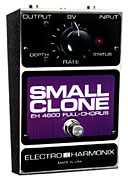 The Small Clone is one of the most famous chorus units. It along with the Small Stone Phase Shifter, were two of the most popular special effects of the ‘70s. Though Electro-Harmonix went out of business in the early ‘80s, they later returned stronger than ever and reissued many of its most popular units. The Small Clone Chorus, according to Electro-Harmonix, is an exact reissue of the original. Well, almost…Electro-Harmonix has begun incorporating true-bypass 3DPT switches into all of its effects.
The Small Clone is one of the most famous chorus units. It along with the Small Stone Phase Shifter, were two of the most popular special effects of the ‘70s. Though Electro-Harmonix went out of business in the early ‘80s, they later returned stronger than ever and reissued many of its most popular units. The Small Clone Chorus, according to Electro-Harmonix, is an exact reissue of the original. Well, almost…Electro-Harmonix has begun incorporating true-bypass 3DPT switches into all of its effects.
Within its basic sheet metal enclosure lies a simple but effective circuit. A control for chorus Rate, a Depth switch, single input and output jacks, and 9v battery (or DC option) round out the Small Clone’s feature set.
With the depth switch engaged, the lush more dominant chorus effects can be had while turning the switch off subdues the effect. While we do wish there was even greater control over chorus depth, we’ll have to admit that the preset settings are good. And the basic chorus analog tone is good, with characteristic analog chorus warmth, and is especially good for the money (the Small Clone is the second-least expensive unit in this roundup). The Small Clone, for being a reissue of an older circuit now nearly three decades old, is surprisingly low-noise as well as transparent of the guitar’s signal.
Like most Electro-Harmonix products, the Small Clone is in fact a bit larger than most other pedals made today and so may take up a bit more real estate on a pedalboard. That said, it is much smaller than other EH products like the Deluxe Memory Man or the Stereo Polychorus that are double the size. So I suppose the Small Clone is “small” when compared to its own other EH relatives.
All in all, the Small Clone is a solid, cost-effective way to get into basic chorusing sounds when quality and warmth of chorus tone matters. www.ehx.com.
Analogman Bi-Chorus $295 + $50 for Stereo option
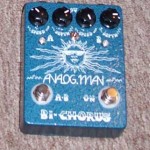 As a substantial feature update to Analogman’s well-known Chorus pedal, the new Bi-Chorus for 2005 is the latest addition to Analogman’s family of pedals. The Bi-Chorus contains all the same analog circuitry, tolerant exact components, and build specifications of the original Analogman Chorus, but adds additional controls to switch between two different chorus settings of your choice. It’s also housed in the same size die-cast aluminum enclosure as its original Chorus sibling. It is finished in a rugged and attractive hammertone blue powder coat finish.
As a substantial feature update to Analogman’s well-known Chorus pedal, the new Bi-Chorus for 2005 is the latest addition to Analogman’s family of pedals. The Bi-Chorus contains all the same analog circuitry, tolerant exact components, and build specifications of the original Analogman Chorus, but adds additional controls to switch between two different chorus settings of your choice. It’s also housed in the same size die-cast aluminum enclosure as its original Chorus sibling. It is finished in a rugged and attractive hammertone blue powder coat finish.
The model we tested had the stereo option as well as a three-position deep switch incorporated for even greater versatility. The standard features include: Speed and Depth controls for side (channel) A and side B of the chorus, pulsing red and yellow LEDs that move with the rate of the chorus swell speed, and two-footswitches to toggle between A/B and to turn the unit on/off (true bypass). Input and output jacks are also mounted on the top as a benefit to maximize pedal board space and cabling. A 9v DC receptacle is also standard.
With two independent sets of Speed and Depth controls, the Bi-Chorus provided us with a range of unique sounds. For example, you can adjust the first set of controls for a very light background chorus, while the second set of controls can be set for a more dramatic Leslie-type effect with all the added pulsation and depth one would expect.
The three-way toggle switch can be activated to go from a lighter airy kind of effect when a subtle chorus is desired, to more dramatic “watery” chorus effects. The Depth knobs from either of the Bi-Chorus channels then take over from there for further fine-tuning of the exact chorus/vibrato effect depth you’re looking for.
The stereo outputs are phase-inverted and deliver wide and spacious sounds that are quite strong and pleasing to the ear when using it with two amps. We especially liked this tone and setup with the amps set clean with no overdrive added. The Bi-Chorus is quite warm and enhances the sound of the strings beautifully. It neither adds nor cuts bass and/or treble and is very transparent in this regard.
Easily the most versatile chorus unit tested out of this group, the Bi-Chorus is an ideal pick for players interested in exploring all of the multiple shades of chorus and vibrato coloring. www.analogman.com.
Electro-Harmonix Stereo Poly Chorus SRP $288
The Stereo Poly Chorus is Electro-Harmonix’ upper-end chorus unit, which is also based on 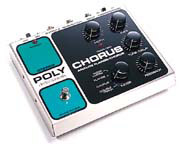 (but had a different name) that musicians such as Kurt Cobain and Adrian Below used. Electro-Harmonix in fact advertises it as: “The final word in chorus pedals The much anticipated reissue of the classic EH pedal that Kurt Cobain and Adrian Belew relied on to create their signature sounds but now in Stereo and with an improved signal-to-noise ratio. The Stereo Polychorus provides the lushest stereo chorus, rich chiming flange, and the over the edge effects that made this versatile pedal legendary.”
(but had a different name) that musicians such as Kurt Cobain and Adrian Below used. Electro-Harmonix in fact advertises it as: “The final word in chorus pedals The much anticipated reissue of the classic EH pedal that Kurt Cobain and Adrian Belew relied on to create their signature sounds but now in Stereo and with an improved signal-to-noise ratio. The Stereo Polychorus provides the lushest stereo chorus, rich chiming flange, and the over the edge effects that made this versatile pedal legendary.”
The Stereo Poly Chorus is indeed control-and-feature-rich with split stereo outputs (dry and wet only), DC 24v operation with included adapter, and controls for Mode (choose between Double Track, Chorus, Flange, or Filter Matrix), Width, Tune/Delay, Rate, and Feedback. In addition, a switch on the top of the unit turns the power of the unit on or off while the footswitch bypasses the unit (true bypass) and activates it. Another onboard switch at the top right turns the Sweep filter on or off. An LED onboard marked “overload” lets users know when the input gain/saturation is up too high.
The thought that comes to mind with this unit is it is the “Jack of all trades and the master of none.” While the intention of this series of reviews is to not compare one unit to the next in terms of what pedal is “better” than another, I can’t help but to state that the Stereo Poly Chorus would probably be best served with a different name. One that implies it has some unusual modulation sounds, but doesn’t claim it to be a chorus, etc. The primary issue with it is that regardless of what setting was chosen between flanging and chorusing, etc., the Stereo Poly Chorus could not provide a basic chorus effect without ALSO imparting a slap-back delay – even with the Tune/Delay turned all the way counterclockwise. The delay sounds in the range of approximately 40-50 ms.
The flanging effect also didn’t sound like a flanging effect and was very subtle – good for some users perhaps, but when something is described as a flange, make it flange. The Filter Matrix is a manually adjustable comb-filter that some players may find useful to dial in different types of static peaks and tonal curves. The Double Track effect does double-track, fortunately but again, with a bit more delay slap time than I would prefer to have – more adjustability would be ideal here.
The Stereo Poly Chorus can create some very unusual effects and sounds that players will enjoy – however, as a chorus effect, it unfortunately falls short of its claim to being, “the final word in chorus pedals.” For chorus, stick with the Small Clone – for unusual delay/modulation effects, the Stereo Poly Chorus may be the ticket. www.ehx.com
Maxon CS-9 Pro Chorus SRP $299
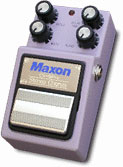 As the manufacturer of Ibanez pedals until only a few years ago, Maxon’s CS-9 is an updated version of its own earlier chorus unit, which it also built under the Ibanez name. While the earlier Maxon/Ibanez chorus only featured Rate and Depth controls, the CS-9 Pro Chorus adds a new Blend control, in addition to a Delay Time, stereo outputs and true bypass switching.
As the manufacturer of Ibanez pedals until only a few years ago, Maxon’s CS-9 is an updated version of its own earlier chorus unit, which it also built under the Ibanez name. While the earlier Maxon/Ibanez chorus only featured Rate and Depth controls, the CS-9 Pro Chorus adds a new Blend control, in addition to a Delay Time, stereo outputs and true bypass switching.
Compact and feature-rich, the CS-9, though based on the same analog chip technology, is tuned for a high-fidelity sound and has a bit more upper-frequency emphasis than the other boxes in this roundup. The blend control is very effective if you are looking for a very subtle mix of chorus rather than an exaggerated wash of color and sound.
The Delay Time control can create some quite dramatic detuned vibrato effects when used with the Depth control set high. About half way up on Delay time and you get a nice chorus effect; go beyond that with depth control set high and now those dramatic time-delay detune effects are at your disposal. This is definitely a unique area to explore within the Maxon unit.
For standard chorus sounds however, and for those that may favor and prefer a crystalline and airy chorus sound which is still pleasing to the ears rather than being a digital ice-pick, the Maxon CS-9 Pro is a good pick. www.maxonfx.com.
Guyatone MC-3 Micro Chorus SRP $85
The Guyatone MC-3 Micro Chorus is a small, cutely housed baby-blue colored chorus that 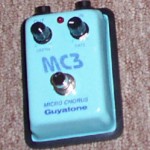 one may mistake for being a toy. The MC-3 has all the basics – it is housed in a stamped-steel enclosure with controls for Rate and Depth and has an on/off footswitch and is 9v operated or can run from an optional 9v DC adapter.
one may mistake for being a toy. The MC-3 has all the basics – it is housed in a stamped-steel enclosure with controls for Rate and Depth and has an on/off footswitch and is 9v operated or can run from an optional 9v DC adapter.
The battery access is done by removing the bottom seal “gasket” and then moving away the bottom plate. This is an interesting and creative take on “no tools” battery access.
Plugged in, the MC-3 clearly demonstrates that it has the analog BBD heritage of its larger and costlier competitors and is far from being a toy. From milder chorusing to deep vibrato, the MC-3 provides all the basic tonal chorusing needs and wants a user could have. It suffers only from being a bit noisier with some audible hiss, but otherwise is very transparent tonally of highs and lows of the guitar. The MC-3 does impart a bit of a boost – you can hear a small step up in volume when you activate the Chorus.
While the MC-3 is not true-bypass, it doesn’t sound like it degrades your bypassed tone as say a wah pedal will. It’s FET buffer does well enough I’d say. For those who have tighter real estate requirements on their pedalboard and/or want a true analog chorus inexpensively, the Guyatone MC-3 is worth checking out. www.godlyke.com.